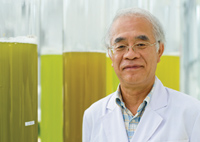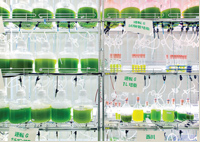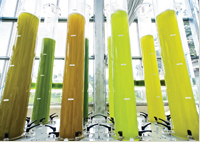- トップページ >
- 日本の魅力 >
- LOOKING TOWARDS THE FUTURE [英語][内閣官房] >
- Energy Powering the future
LOOKING TOWARDS THE FUTURE
ENERGY - Powering the future
Japan plans to push harder for solar, wind, biomass and other renewable
energy technologies – now accounting for 1.6 per cent of power – as a way of weaning itself off nuclear energy.
BIOFUELS
How to make your own oil
Makoto Watanabe (pictured) says Japan could become an oil exporter some day. It sounds absurd: resource-poor Japan imports nearly all of the oil it needs to keep its economy going. But Watanabe, a biofuel expert, is referring to oil made in pools of microalgae.
At the University of Tsukuba, Watanabe's research team grows Botryococcus algae in dozens of large containers and tubes under special lamps, and in a sun-drenched green-house. The algae rely on sunlight, water and carbon dioxide to produce a type of fuel that could power cars, boats or aircraft. Watanabe has been working with city officials in Sendai and Tohoku University on a project at a sewage-treatment plant that uses microalgae to turn waste water into oil. The project is attracting attention because it could remove one of the biggest stumbling blocks in terms of commercialisation: the need for large plots of land for pools to produce algae in mass quantities, which is key to lowering the costs.
“Our biggest hurdles to commercialisation are production costs and the lack of a national programme that would give this momentum”, says Watanabe.Concerned that Japan isn't moving fast enough, he is pushing Japanese researchers in the field to work with scientists overseas to find new ways of taking the idea to the business world.
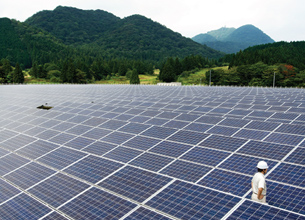
SOLAR FARMS
Working the land
For Softbank, the earthquake and tsunami in 2011 were a call to action. The hi-tech incubator and mobile-phone operator wasted no time rounding up local governors and mayors to help promote renewable energy.
Now Softbank unit SB Energy is racing to put up solar panels around the country, with seven already generating energy for homes and businesses. The idea, says SB Energy deputy president Hiroaki Fujii, is to combat Japan's reliance on large-scale fossil-fuel power plants and nuclear energy.
“We want to show the way for others to enter the field so this industry grows”, he says.
mb.softbank.jp/en
CLEAN-ENERGY GRID
The new battery
The clean-energy grid of the future depends on something that's been around since the 19th century: batteries. On Japan's northernmost island of Hokkaido, the government is investing \20bn (€150m) in a giant battery developed by Sumitomo Electric Industries, which will help stabilise the electricity from solar and wind farms.
The battery uses a metal called vanadium to store energy and will be installed by 2015; it will help Hokkaido's power grids handle the unpredictable flows of power from solar and wind plants. It also gives Japanese firms a shot at breaking into energy markets in Europe and the US.
global-sei.com
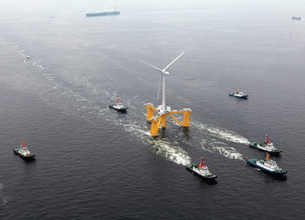
WIND POWER
Floating an idea
With typhoons pounding Japan every year, the country hasn't had much success with wind power. Now the government is investing ¥22bn (€165m) in a concept that could give the country's homegrown industry a boost: floating wind farms. Twenty kilometres off the coast of Fukushima, a consortium of manufacturers and research labs led by the Ministry of Economy, Trade and Industry is testing the first of three floating wind turbines that could eventually be of huge benefit to a region that was hit hard by the 2011 disaster.
Officials say the project, which will run through 2015, will test everything from corrosion-resistant steel to hi-tech floats that can dampen waves and turn turbines to face the wind.
fukushima-forward.jp

GEOTHERMAL ENERGY
Warm glow
Japan ranks third in the world for geothermal potential after the US and Indonesia. Fuji Electric, Toshiba and Mitsubishi Heavy Industries have made improvements in tur-bines and corrosion-resistant pipes since the late 1950s; many global rivals have given up trying. That gives the trio a huge advantage as more countries look to tap this stable source of energy.
Fuji Electric, with a global share of 22 per cent, has been fulfilling orders from Turkey to Indonesia. “geothermal is expensive but our equipment lasts decades”, says Shigeto yamada, the company's geothermal engineering chief.
fujielectric.com
COAL TECHNOLOGY
Cleaning up
Coal gets a bad rap for being a “dirty” energy source but Mitsubishi Heavy Industries has the technology to change that. The integrated coal gasification combined cycle (IGCC) cuts down on pollutants and beats conventional coal-fired turbines in terms of efficiency and operating costs. It also lets utilities burn low-grade coal and its power output can be cranked up quickly to make up for electricity shortfalls from renewable energy.
But researchers aren't finished: the New Energy and Industrial Technology Development Organisation is working on a hi-tech successor.
mhi.co.jp/en/index.html
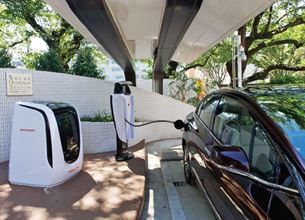
FUEL CELLS
Gear change
Imagine using your car as a back-up generator in a blackout. Since 2012, Honda Motor has been testing the idea. On a full tank a fuel-cell car – which uses hydrogen to generate power – can supply seven hours of electricity to an average Japanese home for six days or several homes for a shorter period.
Honda is running an additional fuel-cell experiment: a refuelling pod for a fuel-cell car. The pod can draw power entirely from solar panels or tap the conventional electricity grid at night and on cloudy days to produce and store hydrogen for fuel-cell cars.
world.honda.com








